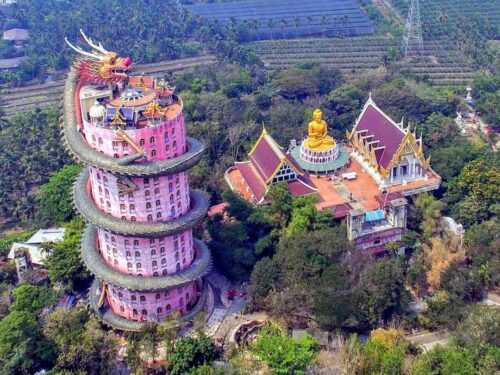Phra Pathom Chedi
Known as the “holiest and first among chedis,” Phra Pathom Chedi is the single most important attraction in this ancient enclave. At 118 meters, (127 meters including the terraces), it is the tallest Buddhist monument in the world, standing higher even than the famous Shwedagon Pagoda in Yangon, Burma.
The legend of the chedi is a tragic one: It’s said that an astrologer told the ancient King Phya Kong that one day his son would kill him. The king sent his son to live in the forest, where a woman found him and raised him. As a young man, the son, called Phya Pan, entered the service of the King of Ratchaburi, who was a vassal of the king of the neighboring kingdom Nakhon Chaisi.
Phya Pan’s great wisdom and prudence brought him to the attention of the king, who adopted him. Phya Pan persuaded him to wage war against his feudal lord and, during the ensuing battle, killed his own father. After the victory, he followed local custom by marrying the queen, his mother, but then learned the story of his origins. The dagoba (tomb) he built as an act of atonement was the predecessor of the Phra Pathom Chedi and is today concealed within the larger structure.
The great chedi stands on a circular terrace in the middle of a square park, surrounded by a latticework wall, with the main entrance on the north side. The bot, one of the buildings on the terrace, holds a Buddha made of clear quartzite and overlaid with lacquer and gold leaf. This Dvaravati-style figure shows the Buddha seated in the European pose, “the Buddha of the future.”
The four wiharns consist of an open lobby and an inner room. A bronze statue of a standing Buddha in the Sukhothai style, known as Phra Ruang Rojanarit, stands in the lobby of the northern wiharn and is a highly revered piece. An inscription on the wall of the wiharn says that the ashes of King Mongkut are interred in the plinth.











